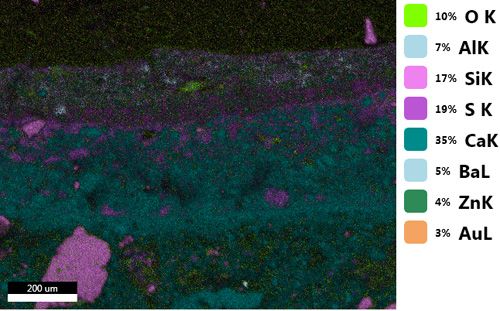Toxic lead identified for theatre redecorators
Electron microscopes aid health and safety concerns with paint compounds as well as accurate restoration of 16th century buildings.
Challenge
Lead, common in old white paints, is toxic in powdered form which is a problem for decorators who sand a wall or ceiling surface before repainting it.
In old buildings, such as theatres, lead white is common even in brighter colours such as red paints.
So decorating companies have to check for toxicity when redecorating in these buildings, which can only be done by taking a sample of the paints and investigating all of the different paint layers from previous re-decorations, and analysing the chemical composition of miniscule pigment particles.
Solution
To identify the chemical composition of the paint layer, a technique that uses a unique emission of electrons is needed.
X-rays are ideal for this as they provide unique spectra depending on what element the x-ray hits, allowing a high resolution map to be produced, showing the precise locations and distributions of the lead particles.
The paintings conservator told us what elements they were looking for and then we produced elemental maps to show where the lead particles were, as well as other pigment indicating ions, such as Ba and Zn, which allowed further interpretation of the pigments used in previous decorating phases.

Energy dispersive x-ray analysis allows the micron level distribution of elements to be identified. Here, the lead white layer is clearly indicated, as well as particles of arsenic and zinc in the earlier pigments used.
Elemental map provided by Adel El-Turki.
Impact
The analyses showed a very homogeneous lead particle distribution, so the decorators would have to be extremely careful to avoid inhalation of any airborne powders, of white, blue or red paints.
The Ba and Zn indicated modern pigments which corroborates the dating of the layers to specific periods that the conservator was able to match to historic photographs of the building, allowing restoration to previous periods to take place using replica pigments and colour schemes.
